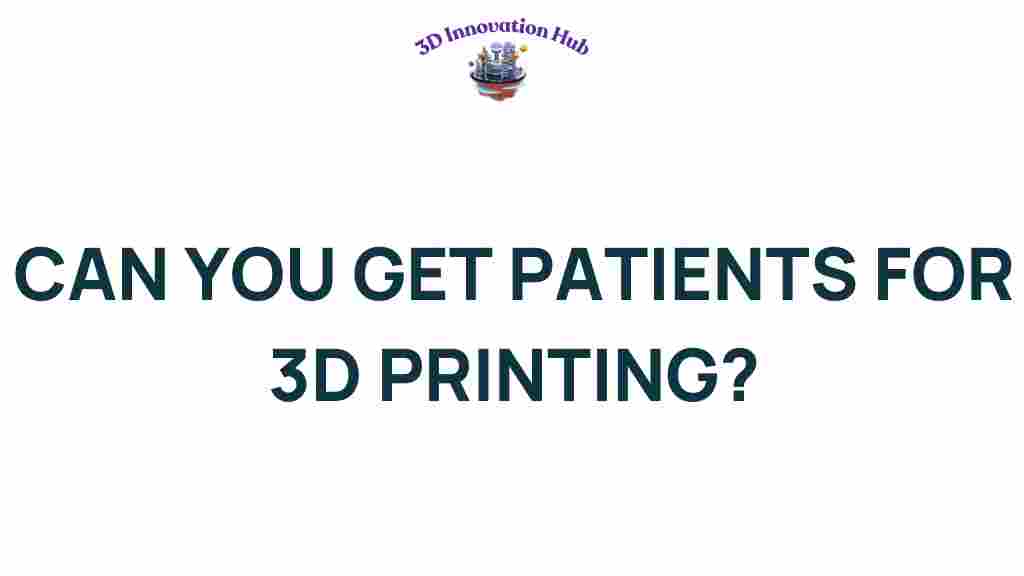Unveiling the Potential: Can 3D Printing Revolutionize Patient Care?
In recent years, the intersection of 3D printing and healthcare has sparked significant interest among medical professionals and innovators alike. As technology continues to advance, additive manufacturing has emerged as a game-changing tool in the field of patient care. This article explores how 3D printing is poised to revolutionize the landscape of medical innovations and personalized medicine.
The Rise of 3D Printing in Healthcare
3D printing, also known as additive manufacturing, involves creating three-dimensional objects from digital files. This technology has been adopted across various industries, but its application in healthcare has been particularly transformative. Here are some key areas where 3D printing is making a significant impact:
- Prosthetics and Orthotics: Customized prosthetic limbs and orthotic devices can be quickly and affordably produced to meet the specific needs of individual patients.
- Surgical Models: Surgeons can create precise anatomical models based on a patient’s scans, allowing for better pre-surgical planning.
- Bioprinting: The potential to print tissues and organs could address the growing need for transplants.
- Medical Devices: Custom-fit medical devices such as hearing aids and dental implants can be produced with increased accuracy.
How 3D Printing Works in Patient Care
Understanding how 3D printing integrates with patient care helps appreciate its full potential. Here’s a step-by-step process of how it works:
- Data Collection: The process begins with collecting patient data, often through imaging techniques such as MRI or CT scans.
- Digital Modeling: This data is transformed into a digital 3D model using specialized software, allowing for precise customization.
- 3D Printing: The model is then sent to a 3D printer, which constructs the object layer by layer using various materials, such as plastics, metals, or even bio-inks.
- Post-Processing: After printing, the object may require finishing touches, such as polishing or sterilization, before being used in a clinical setting.
Applications of 3D Printing in Patient Care
As the technology evolves, numerous applications of 3D printing in healthcare continue to emerge. Here are some notable examples:
1. Customized Surgical Instruments
Surgeons can benefit from 3D printed surgical tools tailored to specific procedures, enhancing precision and efficiency.
2. Anatomical Models
Creating patient-specific models allows for enhanced understanding and visualization of complex anatomies, leading to better surgical outcomes.
3. Tissue Engineering
With advancements in bioprinting, researchers are working toward printing functional tissues and organs, which could address transplant shortages.
4. Education and Training
Medical students and professionals can use 3D printed models for hands-on training, improving their skills and understanding of human anatomy.
Benefits of 3D Printing in Healthcare
The integration of 3D printing into patient care offers several remarkable benefits:
- Personalization: Each product can be tailored to the individual needs of the patient, enhancing comfort and functionality.
- Cost-Effectiveness: Producing custom devices and models can be more affordable than traditional manufacturing methods.
- Speed: The rapid production of prototypes and final products reduces waiting times for patients.
- Innovation: Encourages the development of new solutions and techniques in medical innovations.
Challenges and Limitations
While the benefits of 3D printing in healthcare are substantial, there are also challenges that must be addressed:
- Regulatory Issues: Navigating the regulatory landscape for new materials and devices can be complex.
- Material Constraints: Currently, the materials used in 3D printing may not always meet the rigorous standards required for medical applications.
- Skill Gap: There is a need for trained professionals who can operate 3D printing technology and interpret medical data accurately.
Troubleshooting Common Issues in 3D Printing for Healthcare
As with any technology, 3D printing can encounter issues. Here are some common problems and troubleshooting tips:
1. Print Failures
If a print fails, check the following:
- Ensure the printer is calibrated correctly.
- Verify that the correct material is loaded and is of good quality.
- Check the digital model for errors.
2. Inaccurate Dimensions
To address inaccuracies:
- Double-check the original scans and ensure they are correctly converted into a digital model.
- Review the printer settings to ensure they match the specifications of the model.
3. Material Issues
If the printed object does not meet strength or flexibility requirements:
- Consider using different materials that may better suit the intended application.
- Consult material safety data sheets to ensure compatibility with medical standards.
The Future of Healthcare and 3D Printing
The future of healthcare is undoubtedly intertwined with advances in 3D printing. As technology continues to evolve, we can expect:
- Increased Adoption: More healthcare facilities will incorporate 3D printing into their practices.
- Broader Applications: The potential for bioprinting organs and tissues may soon become a reality.
- Enhanced Collaboration: Greater synergy between engineers, medical professionals, and researchers will drive innovation.
Conclusion
In conclusion, 3D printing holds immense promise for transforming patient care through innovative medical technologies and solutions. The personalization offered by additive manufacturing not only enhances the quality of care but also opens new avenues for personalized medicine. While challenges remain, the ongoing advancements in 3D printing will undoubtedly shape the future of healthcare in profound ways. As we continue to embrace these innovations, the potential for improved patient outcomes is limitless. For more information on the impact of technology in healthcare, visit this resource.
Explore further insights on medical innovations and how they can enhance your understanding of 3D printing in healthcare by checking out this article.
This article is in the category and created by 3D Innovation Hub Team
